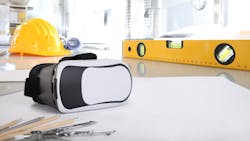A recent survey of construction executives finds more than half are planning to invest in augmented reality technology in the next two years, a possible indication of the tool’s maturation and the industry’s growing recognition of its practical value in better melding project design and construction functions.
The findings, compiled in a new market research report from GlobalData PLC, London, faintly echo those from a series of annual EC&M surveys of electrical contractors and electrical design firms that point to a slow uptick in utilization of AR in projects in recent years.
The GlobalData report, which defines AR as “a technology that allows the user to see the real world overlaid with a layer of digital content such as sensor-based data, location-based data, sound, video, or graphics,” builds a case that the construction industry is fertile ground for greater adoption of AR because it is both hungry for efficiency improvements and lagging in deployment. With 55% of construction executives surveyed in late 2021 saying they planned to invest in AR in the next two years; one-third saying they had no plans to do so; and projections for 17-fold growth of AR globally through 2030, GlobalData says the stars could be aligning for AR in construction.
Quoted in a news release on the report, the firm’s Robert Penman said firms could be waking up to AR’s potential in “building models to be positioned on site through headsets or smart glasses, so they can be compared to the construction site,” enabling users to “easily notice errors before further work occurs, avoiding unnecessary rework and using additional expensive materials.” And he adds that “the more complex mechanical, electrical, and plumbing (MEP) elements a project requires, the more the project will gain from AR.”
AR’s prospects in construction, though, are hindered in the short term by tougher business conditions and lack of will to invest in technology despite growing recognition of its need, GlobalData says. The company advances the idea that increased investment in technology generally and AR specifically will also help the industry address its recruiting challenges while “increasing project accuracy, supporting collaborative design, and enabling stakeholder engagement.”
Electrical contractors and designers surveyed by EC&M annually appear to understand those potential benefits of AR, saying collaboration broadly is a top likely benefit, but a majority continue to say utilization is still down the road a piece. The share of firms saying they’re using AR has inexplicably bounced around through the years but has never topped 50%. However, in the latest Top 40 electrical design firm survey, 47% did say they were using it, up from 28% in the year-before survey. As for electrical contractors, only 26% in the last year’s Top 50 survey said they were currently using AR, up from 18% in the prior year survey.
One design firm that says AR is slowly being integrated, Harley Ellis Devereaux, Southfield, Mich., points to its potential for helping clients gain enhanced visualization of designs. Associate principal Kenneth Golovko says that capability could help break down barriers to timely project completion, “showing different options more clearly to avoid change orders down the line.” He also sees AR coming into play in post-completion, where detailed information embedded in design models can be utilized in project deliverables such as maintenance manuals.
Scott Wheeler, an executive with The Engineering Enterprise, Alameda, Calif., says the firm has dabbled in AR but that is has, so far, demonstrated little added value.
“I don’t know that it’s really taken off the way we thought it would when we saw it as something we’d see everywhere,” he says. “We’ve investigated whether we can design better with it, but there’s not been a lot of positive feedback from staff on it.”
About the Author
Tom Zind
Freelance Writer
Zind is a freelance writer based in Lee’s Summit, Mo. He can be reached at [email protected].
